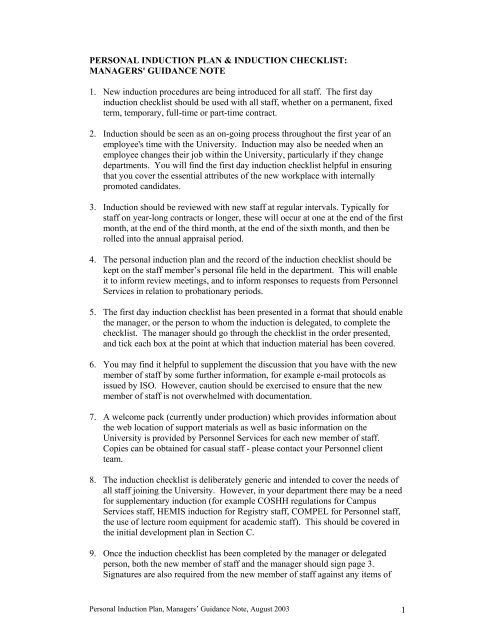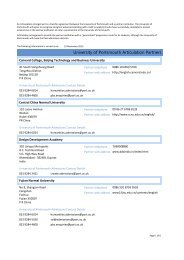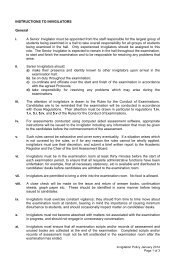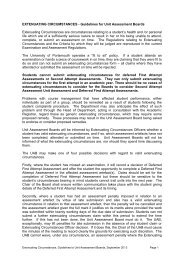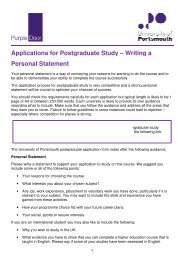Personal Induction Plan and Induction Checklist
Personal Induction Plan and Induction Checklist
Personal Induction Plan and Induction Checklist
Create successful ePaper yourself
Turn your PDF publications into a flip-book with our unique Google optimized e-Paper software.
PERSONAL INDUCTION PLAN & INDUCTION CHECKLIST:<br />
MANAGERS' GUIDANCE NOTE<br />
1. New induction procedures are being introduced for all staff. The first day<br />
induction checklist should be used with all staff, whether on a permanent, fixed<br />
term, temporary, full-time or part-time contract.<br />
2. <strong>Induction</strong> should be seen as an on-going process throughout the first year of an<br />
employee's time with the University. <strong>Induction</strong> may also be needed when an<br />
employee changes their job within the University, particularly if they change<br />
departments. You will find the first day induction checklist helpful in ensuring<br />
that you cover the essential attributes of the new workplace with internally<br />
promoted c<strong>and</strong>idates.<br />
3. <strong>Induction</strong> should be reviewed with new staff at regular intervals. Typically for<br />
staff on year-long contracts or longer, these will occur at one at the end of the first<br />
month, at the end of the third month, at the end of the sixth month, <strong>and</strong> then be<br />
rolled into the annual appraisal period.<br />
4. The personal induction plan <strong>and</strong> the record of the induction checklist should be<br />
kept on the staff member’s personal file held in the department. This will enable<br />
it to inform review meetings, <strong>and</strong> to inform responses to requests from Personnel<br />
Services in relation to probationary periods.<br />
5. The first day induction checklist has been presented in a format that should enable<br />
the manager, or the person to whom the induction is delegated, to complete the<br />
checklist. The manager should go through the checklist in the order presented,<br />
<strong>and</strong> tick each box at the point at which that induction material has been covered.<br />
6. You may find it helpful to supplement the discussion that you have with the new<br />
member of staff by some further information, for example e-mail protocols as<br />
issued by ISO. However, caution should be exercised to ensure that the new<br />
member of staff is not overwhelmed with documentation.<br />
7. A welcome pack (currently under production) which provides information about<br />
the web location of support materials as well as basic information on the<br />
University is provided by Personnel Services for each new member of staff.<br />
Copies can be obtained for casual staff - please contact your Personnel client<br />
team.<br />
8. The induction checklist is deliberately generic <strong>and</strong> intended to cover the needs of<br />
all staff joining the University. However, in your department there may be a need<br />
for supplementary induction (for example COSHH regulations for Campus<br />
Services staff, HEMIS induction for Registry staff, COMPEL for Personnel staff,<br />
the use of lecture room equipment for academic staff). This should be covered in<br />
the initial development plan in Section C.<br />
9. Once the induction checklist has been completed by the manager or delegated<br />
person, both the new member of staff <strong>and</strong> the manager should sign page 3.<br />
Signatures are also required from the new member of staff against any items of<br />
<strong>Personal</strong> <strong>Induction</strong> <strong>Plan</strong>, Managers’ Guidance Note, August 2003 1
equipment or special access entitlements that they are given. This is shown on<br />
page 2. On the termination of employment the manager's signature signals that<br />
property belonging to the University has been returned, <strong>and</strong> that special passwords<br />
etc have been cancelled. This latter is done through ISO <strong>and</strong> you should contact<br />
the Help Desk for information.<br />
10. The first day induction should be started the day the new member of staff joins the<br />
University, or transfers to a new department. However, it may need to span the<br />
first two or three days, <strong>and</strong> managers should use their discretion to ensure that new<br />
employees are not overburdened with information.<br />
11. Personnel Services will send a reminder one month after the member of staff’s<br />
date of appointment <strong>and</strong> ask you to confirm that this induction has been<br />
completed.<br />
12. In Section B, under General Welfare, there is the opportunity for new members of<br />
staff to identify any specific personal needs that they may have. There is no<br />
management requirement to probe in this area, but rather it is an opportunity for<br />
any special requirements that may be related to disability, health, or other personal<br />
requirements to be noted. If the new member of staff has no special needs that<br />
they wish to record, you can simply tick the box <strong>and</strong> mark none against it.<br />
13. The induction checklist provides an opportunity to identify immediate knowledge<br />
<strong>and</strong> training needs. These may already have been identified in the interview<br />
process <strong>and</strong>/or by the appointment panel in determining the appointment. It is<br />
likely, however, that training <strong>and</strong> development needs will emerge as the new<br />
member of staff settles into their post, <strong>and</strong> these should be picked up at subsequent<br />
review meetings. You may find it helpful to refer to the University’s Continuing<br />
Professional Development Policy in determining which training needs should be<br />
prioritised <strong>and</strong> which, though aspirational, cannot be met.<br />
14. Many managers find it helpful to present new members of staff with two pieces of<br />
information: an organo-diagram showing the structure of the department <strong>and</strong><br />
where the new employee fits into that structure; <strong>and</strong> a telephone directory which<br />
enables them to underst<strong>and</strong> better who individuals are <strong>and</strong> how departments are<br />
located across the University.<br />
15. In summary it is the responsibility of the manager to ensure that the form remains<br />
a part of the personal file of the new member of staff, <strong>and</strong> where responsibility for<br />
induction or parts of the induction programme are delegated to others, that the<br />
completed form is returned promptly to that file.<br />
16. Any queries concerning the use of this induction form should be addressed to<br />
Personnel Services through your Personnel client team.<br />
<strong>Personal</strong> <strong>Induction</strong> <strong>Plan</strong>, Managers’ Guidance Note, August 2003 2


